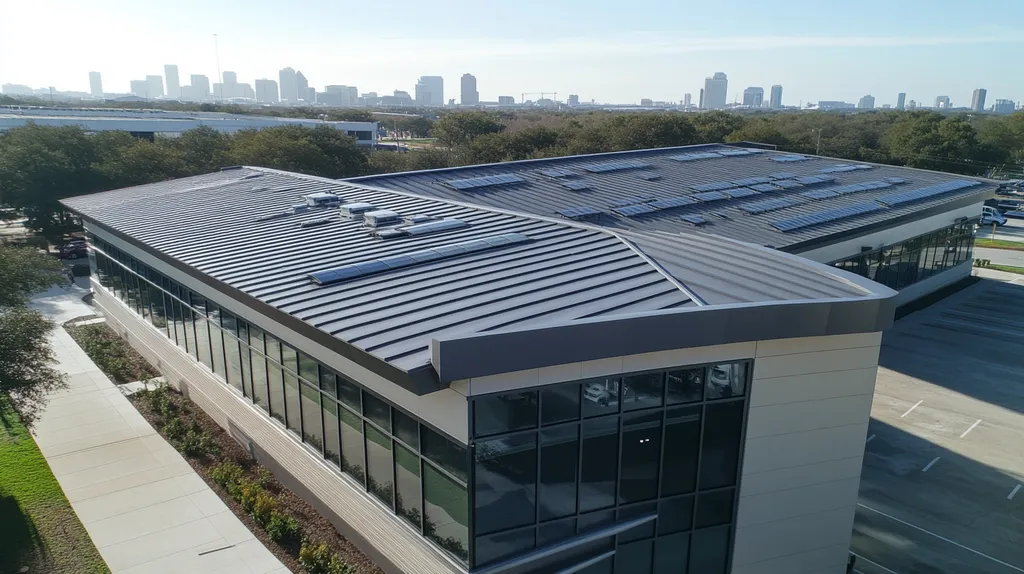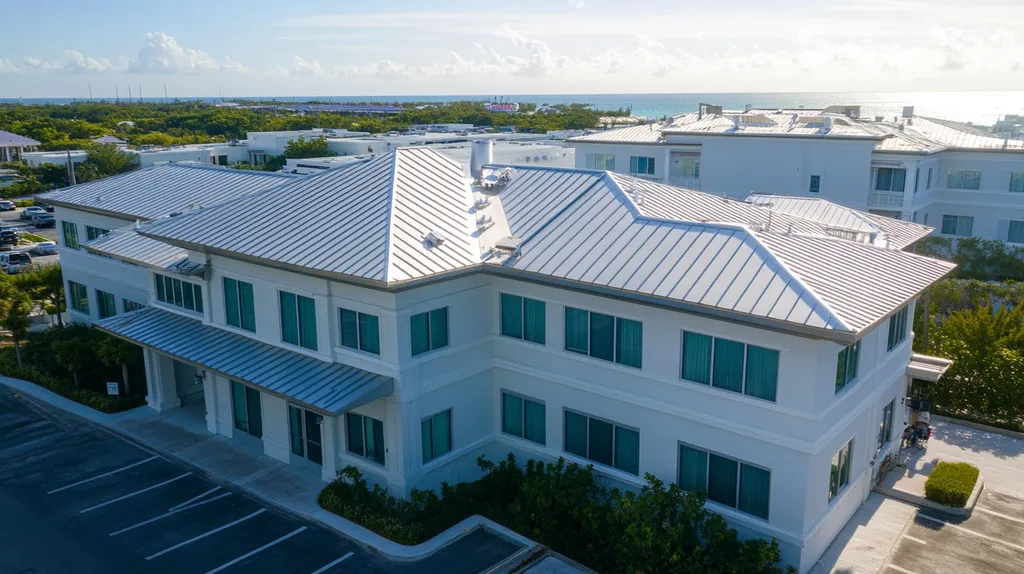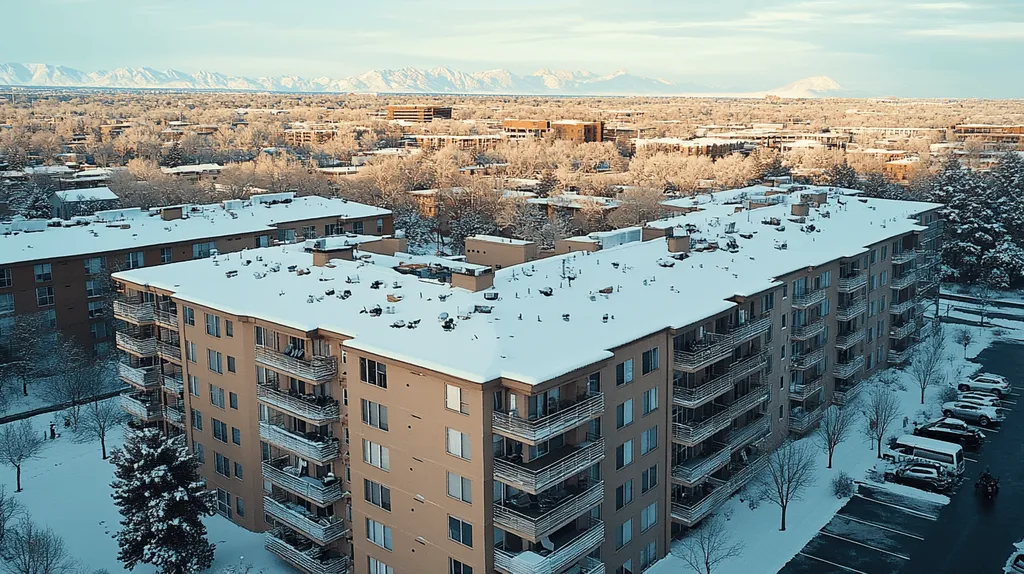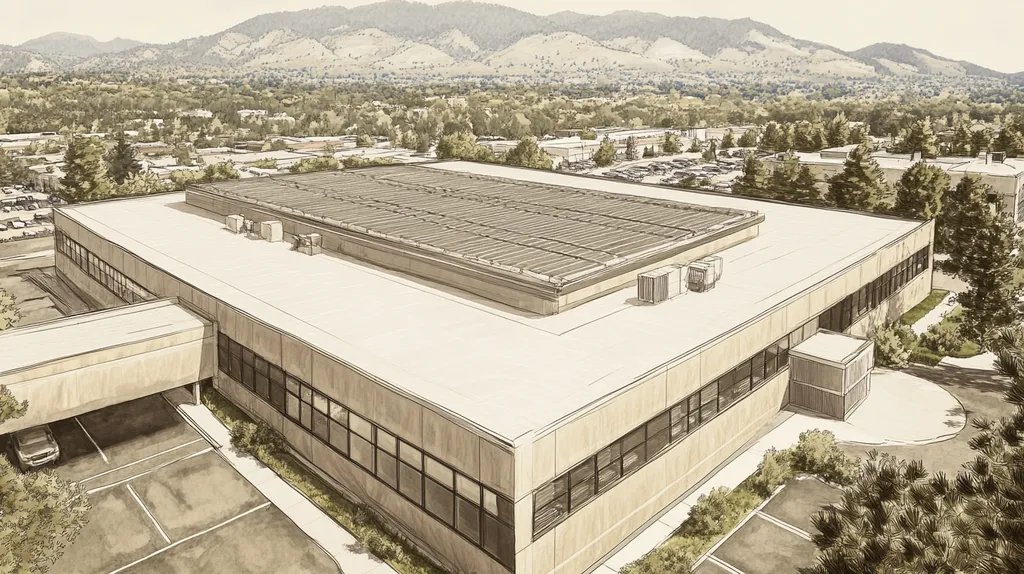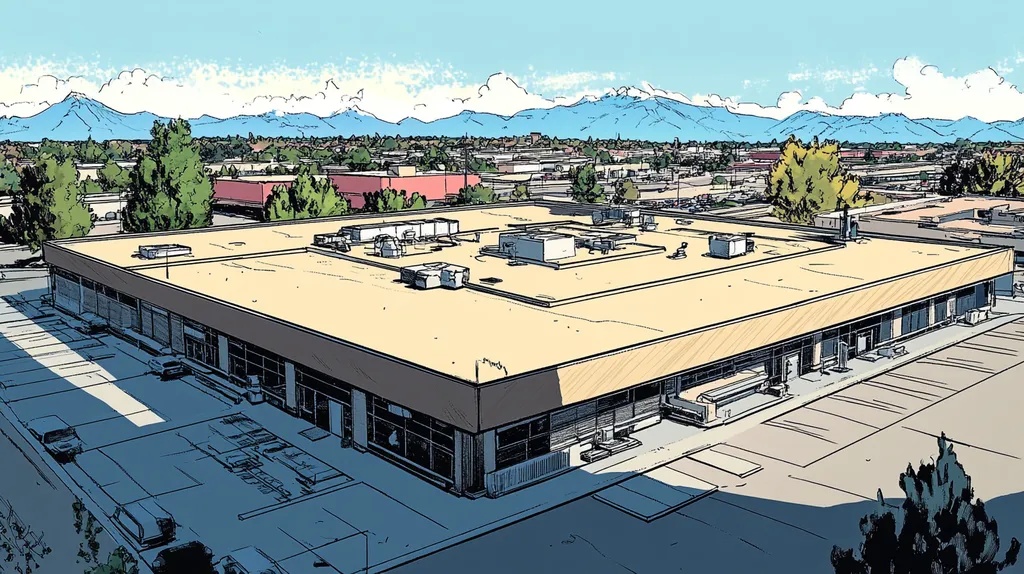In the world of commercial roofing, inspection frequency can mean the difference between a minor repair and catastrophic failure. Studies show that up to 85% of commercial roof failures could have been prevented through proper inspection schedules.
Today’s advanced roofing systems, while more durable than their predecessors, still require vigilant monitoring to achieve their projected lifespans of 20-30 years.
From seasonal assessments to post-storm evaluations, understanding when and how often to inspect a commercial roof has become crucial for property owners and facility managers seeking to protect their investments.
SECTION 1: FUNDAMENTAL CONCEPTS
The stakes are high when it comes to the inspection of commercial roofs. Regular inspections are not merely suggested; they are critical for preserving the integrity of a building and preventing expensive repairs. Research indicates that neglecting this essential task can lead to over 30% of commercial roofs experiencing major leaks. Such leaks threaten not only the structure’s safety but also the comfort of its occupants. Addressing potential roofing concerns early can avert disasters that compromise both budgets and safety.
Importance of Regular Inspections
Regular inspections serve as the backbone of a well-maintained commercial roof. They allow for the timely identification of minor issues before they mushroom into significant problems. For instance, a mere small crack can evolve into severe water damage if left unattended.
Establishing a proactive inspection schedule can markedly prolong the lifespan of roofing materials. In fact, roofs that receive consistent care can last 15 to 20 years longer than those that do not. This not only minimizes replacement expenses but also enhances long-term budgeting plans.
Moreover, regular inspections ensure compliance with local building codes and safety standards. Consistent documentation of roof conditions can shield building owners from potential legal liabilities, adding another layer of protection to their investment.
Ultimately, routine inspections foster a safer environment for everyone using the facility, bolstering the overall property value.
Types of Commercial Roofs
A key element of effective roof maintenance is understanding the different types of commercial roofs. Among them, flat roofs are the most common due to their affordability and straightforward installation.
Pitched roofs, which excel in drainage capabilities, and green roofs, known for their environmental advantages, also play significant roles in commercial architecture. Each roofing type presents unique maintenance challenges that must be recognized for proper care.
For instance, flat roofs are often susceptible to water pooling, making frequent inspections essential. Conversely, while pitched roofs are less prone to standing water, they can suffer from issues such as shingle wear and concerns regarding structural integrity.
Identifying the specific roofing system in place is crucial for determining appropriate inspection intervals and focal points, paving the way for comprehensive maintenance strategies.
Common Roofing Issues
Commercial roofs can encounter a variety of common issues, all of which can be mitigated through regular inspections. Membrane deterioration stands out as a frequently occurring problem that can instigate leaks. If left unaddressed, these leaks threaten both the roof itself and the interior of the building.
Another challenge is debris accumulation, which can obstruct drainage and lead to dangerous ponding. When water collects on the roof for prolonged periods, it accelerates deterioration and heightens existing vulnerabilities.
Pest infestations, especially within insulating materials, also pose a threat. These intrusions can undermine the roof’s safety and performance, creating hidden hazards over time.
Identifying these concerns early during inspections allows for timely repairs, effectively saving property owners money in the long run and preventing more severe complications from emerging.
SECTION 2: SYSTEM COMPONENTS
Understanding the various components of a commercial roofing system is crucial for maintaining its integrity and functionality. Each element contributes significantly to the roof’s overall performance and longevity. Neglecting these components during routine inspections can lead to serious damage and costly repairs. For example, a minor drainage issue can escalate into major structural problems, affecting the entire building.
Roofing Materials and Durability
The choice of roofing material profoundly affects the lifespan and reliability of a roof. Take TPO (Thermoplastic Olefin), for example; it is favored for its energy efficiency and UV resistance. However, materials like EPDM (Ethylene Propylene Diene Monomer) are known for their exceptional durability against harsh weather conditions.
When selecting roofing materials, property owners must consider local climate factors. In regions prone to heavy rainfall, water resistance becomes indispensable. Ignoring the durability of roofing materials can result in deterioration and elevating maintenance costs over time.
Regular inspections are vital for spotting early indications of wear. Cracks or blisters on TPO roofs, for instance, may signal that replacement is around the corner. Taking timely action based on the material’s condition can significantly extend the roof’s life.
Investing in high-quality materials may create an initial expense but pays off in reduced repair frequency over time. Therefore, understanding material options and their implications is essential for effective roof management.
Drainage and Water Management
Effective drainage is a cornerstone of any commercial roofing system. Poor water management can lead to ponding, which is one of the leading causes of roof failure. Standing water damages roofing membranes and can encourage mold growth, posing further health risks.
Regularly checking gutters and downspouts for clogs or cracks is essential. A single blockage can compromise the entire drainage system, leading to water accumulation. This not only reduces the roof’s lifespan but can also threaten structural integrity.
Landscaping and surrounding features influence water flow as well. A well-designed drainage system should consider runoff from nearby areas to prevent water from pooling on the roof. Features like internal drains or scuppers can enhance drainage effectiveness, especially in flatter roof designs.
Inspection frequency should align with local weather patterns. Higher precipitation seasons necessitate more frequent checks to ensure the effective operation of drainage systems. Addressing drainage challenges early is crucial for preventing extensive damage and costly repairs.
Roof Penetrations and Equipment
Roof penetrations are common yet often present significant risks if not properly maintained. Features like HVAC units, vents, and skylights can create leak potential if seals fail or flashings deteriorate. Each penetration warrants close examination during inspections to ensure waterproof integrity.
Routine checks of these elements can prevent minor issues from turning into major leaks or damage. For instance, compromised flashing around a vent can result in water intrusion, damaging both the roof and the interior spaces. Identifying and rectifying these problems can save property owners from substantial repair costs.
The position and installation of rooftop equipment also affect the roof’s overall performance. Incorrect installation can place undue stress on the roofing membrane, while poorly arranged equipment might prevent proper drainage. Thoughtful planning and regular inspections are key to mitigating these risks effectively.
Ensuring that all rooftop equipment is securely installed and functioning optimally is a cornerstone of proactive maintenance. Just like other components, aligning inspection frequencies with environmental conditions contributes to sustaining a healthy roofing system.
SECTION 3: IMPLEMENTATION METHODS
Regular and thorough roof inspections are not just best practices; they are essential for the longevity and reliability of commercial roofs. Statistics reveal that a staggering 85% of roof failures can be traced back to preventable issues, many of which arise due to neglect of routine inspections. By establishing a proactive inspection schedule, property owners can avoid hefty repair bills and significantly extend the life of their roofing systems. This section delves into effective strategies for implementing roofing inspections, with a focus on seasonal scheduling, timely post-weather assessments, and the benefits of advanced inspection techniques.
Scheduling Inspections Seasonally
Setting a seasonal inspection schedule is crucial for maintaining the integrity of commercial roofs. Ideally, inspections should be conducted at least four times a year—before winter, spring, summer, and fall—to address seasonal challenges like snow loads and heavy rainfall that can compromise roof integrity.
In winter, inspectors must pay close attention to ice dam formation and drainage issues. Spring inspections should focus on snowmelt-related leaks and checking for debris buildup. During summer, wear from extreme heat and UV exposure can be evaluated, while fall inspections prepare the roof for the approaching winter months.
Property owners in areas prone to heavy rain or snowfall must adjust their inspection frequencies accordingly. Regular seasonal checks not only help in identifying potential problems before they escalate but also keep the roof functioning effectively throughout the year.
Documenting inspection findings is essential. Facility managers should maintain detailed records to track changes and trends over time, which can be invaluable for budget planning and forecasting future maintenance needs.
Post-Weather Event Inspections
After severe weather events, inspections become especially critical for identifying damage that may not be visible at first glance. Intense storms, hail, or extreme temperatures can inflict significant harm, making prompt evaluation essential.
For instance, high winds from a storm can dislodge roofing materials or loosen flashings, leading to potential leaks. After such events, facility managers should prioritize inspections to evaluate vulnerabilities. Failing to catch damage promptly can lead to serious water infiltration and structural issues.
Thorough documentation of conditions following extreme weather can provide critical evidence for insurance claims and help inform decisions regarding necessary repairs. Photos and detailed observations serve as a record of the roof’s performance under stress, aiding in future planning.
Establishing a standard protocol for post-event inspections ensures timely and effective responses to damage. This not only mitigates risks but also fosters a proactive attitude toward roof maintenance, ultimately protecting the value of the asset.
Using Advanced Inspection Techniques
Integrating advanced inspection techniques can significantly improve the detection of hidden roofing problems. While traditional visual inspections are a staple in roof maintenance, technologies such as infrared thermography, drones, and moisture mapping offer a more comprehensive assessment of roof conditions.
Infrared thermography helps uncover temperature variances that indicate moisture retention, which is often a precursor to more severe damage. Drones provide a safe and efficient means to inspect hard-to-reach areas, allowing for a thorough review without risking worker safety.
Moisture mapping technologies can precisely identify trapped water within roofing materials, enabling timely intervention in response to emerging issues. Leveraging these advanced tools streamlines the inspection process and helps prevent more serious complications.
Property owners should see these techniques as valuable investments in the longevity of their roofs. While initial costs may be higher, the potential savings from avoiding extensive damage make them worth the expenditure, reinforcing the importance of proactive maintenance strategies.
SECTION 4: MAINTENANCE REQUIREMENTS
Regular maintenance is not just a best practice; it’s a lifeline for the longevity of a commercial roof. Alarmingly, approximately 80% of roofing failures stem from inadequate maintenance protocols. By establishing a consistent inspection schedule, building owners can stave off extensive repairs and significantly extend their roofs’ operational life. This section will explore how to tailor inspection frequencies to specific factors, the necessity of both interior and exterior evaluations, and effective strategies for addressing visible and hidden damage.
Frequency of Inspections Based on Factors
The frequency of roof inspections is influenced by various factors, including geographic location, roof material, and building age. For example, roofs situated in areas prone to heavy rainfall may require inspections every six months, while those in arid regions might only need an annual checkup.
Additionally, the design and use of a roof can determine how often inspections are needed. Flat roofs that struggle with drainage may benefit from quarterly examinations to catch any water pooling issues early. Facilities with high foot traffic or significant mechanical installations should also adhere to a more frequent inspection routine.
Seasonal changes present another critical factor. Conducting inspections before severe weather conditions can help prepare the roof to withstand added stress, allowing for the early identification of potential vulnerabilities that could lead to extensive damage.
Interior and Exterior Evaluation
A thorough roof evaluation incorporates both interior and exterior inspections. Externally, inspectors look for visible damage like loose shingles, punctures, or standing water. Such indicators may point to underlying problems that could escalate into severe issues like leaks or structural compromises.
Interior evaluations are equally crucial, revealing the hidden impacts of any exterior shortcomings. Signs of water damage, mold growth, or sagging ceilings can indicate leaks that have infiltrated the building. Regular inspections of attic spaces and ceilings help provide a comprehensive picture of any ongoing challenges.
By conducting simultaneous interior and exterior evaluations, property owners can more effectively identify systemic problems. For instance, persistent water intrusion inside a facility may reflect chronic exterior damage, prompting timely action to maintain roofing integrity.
Addressing Visible and Hidden Damage
Timely intervention is key to maintaining a roof’s health. Visible damage, such as missing shingles or cracks, should be repaired without delay to avoid further escalation. Regular inspections facilitate quick identification, enabling property owners to implement cost-effective solutions.
However, hidden damage poses a more insidious threat. Leaks may develop unnoticed, leading to structural degradation and mold over time. Routine interior inspections are essential for catching these issues early, thereby minimizing the risk of extensive repairs as they arise.
Adopting both reactive and proactive maintenance strategies significantly enhances a roof’s longevity. Property owners are encouraged to document all findings and repairs diligently, creating a robust maintenance record that guides future assessments. Such thorough records will prove invaluable when planning long-term maintenance strategies and allocating budgets.
SECTION 5: PERFORMANCE METRICS
Understanding the performance metrics of commercial roofing is crucial for property owners and facility managers. Delaying inspections can lead to significant problems, including costly repairs and premature roof replacements. For instance, a neglected roof may experience leaks that escalate into structural damage, affecting the entire property. By assessing key performance factors, stakeholders can make informed decisions that extend the life of the roof while minimizing financial risk. This section dives into assessing roof condition and lifespan, identifying potential problems early, and conducting a cost-benefit analysis of regular inspections.
Assessing Roof Condition and Lifespan
Evaluating the condition of a commercial roof is essential for informing maintenance decisions and planning replacements effectively. Regular inspections offer vital insights into the roof’s materials, allowing property managers to identify signs of wear and tear, such as missing shingles or pooling water. Addressing these issues promptly can prevent costly repairs down the line.
Understanding the roof’s expected lifespan assists in budgeting and resource allocation. Many commercial roofs are designed to last 20 years or more with consistent upkeep, but that lifespan can be drastically cut short without routine monitoring. Managers should diligently track the age and condition of roofing systems to anticipate any potential failures.
Utilizing performance metrics can streamline maintenance procedures. By grading the roof’s condition, managers can prioritize repairs based on urgency and impact. This proactive approach not only mitigates risks but also enhances financial forecasting of roofing expenses.
Ultimately, regular assessments lead to a strategic plan that keeps the roof in optimal condition, safeguarding the investment and boosting property value.
Identifying Potential Problems Early
Early detection of roofing issues can save property owners significant money and stress. Routine inspections can reveal minor deterioration signs, such as cracks or leaks, before they escalate into major problems. For instance, if a small leak is neglected, it could lead to severe water damage and mold growth, often requiring extensive repairs.
Moreover, performance metrics enable facility managers to track the roof’s historical data over time. Measuring trends in wear and identifying patterns allows stakeholders to pinpoint areas of concern needing enhanced monitoring. This data-driven approach fosters accountability in maintenance practices and can guide timely interventions.
Predictive analytics can also be employed to anticipate future issues based on current conditions. For example, when a roof shows symptoms of thermal expansion, it can be flagged for monitoring during temperature shifts to prevent potential ruptures. This foresight not only extends the roof’s life but also reduces costs related to emergency repairs.
Effectively identifying problems early enhances safety for tenants and employees alike, while maintaining the structural integrity of the property. Routine inspections become indispensable, paving the way for sustainable solutions for both the roof and the business it shelters.
Cost-Benefit Analysis of Inspections
Investing in regular roof inspections can yield substantial long-term savings. A proactive maintenance approach addresses issues before they escalate, ultimately reducing repair costs significantly. For instance, spending $1,000 on inspections may help prevent a $10,000 emergency repair caused by deferred maintenance.
A thorough cost-benefit analysis can assist property managers in evaluating the frequency of inspections against potential expenditures. Understanding that the costs associated with inspections are generally far lower than those for repairs or replacements justifies this investment. The old adage rings true: “an ounce of prevention is worth a pound of cure.”
Additionally, implementing a strategic inspection schedule can positively affect insurance premiums. Insurers often provide incentives to property owners demonstrating proactive maintenance efforts, translating into lower rates. This financial benefit underscores the value of regular roofing inspections.
In conclusion, performing routine inspections is not only about improving roof performance; it’s also about ensuring the overall health of the property. This sustainable approach leads to significant financial savings and maximized value throughout the property’s lifecycle, providing clear advantages for those managing commercial buildings.
SECTION 5: PERFORMANCE METRICS
In the realm of commercial roofing, understanding performance metrics is not just beneficial; it’s crucial. Neglecting routine inspections can set off a chain reaction of problems, resulting in costly repairs or premature roof replacements. For example, roofs that go unchecked may develop leaks, leading to extensive structural damage that affects the entire property. By evaluating performance metrics, property owners and facility managers can make informed decisions that help extend the life of their roofs while minimizing financial risks. This section explores roof condition and lifespan assessment, early identification of potential problems, and the cost-benefit analysis of regular inspections.
Assessing Roof Condition and Lifespan
Evaluating the condition of a commercial roof is essential for effective maintenance and timely replacement decisions. Regular inspections yield insights into the integrity of roofing materials, helping identify wear and tear such as missing shingles or pooling water that requires immediate attention.
Understanding the roof’s expected lifespan also aids in budget planning and resource allocation. Many commercial roofs can exceed 20 years with proper maintenance, but regular monitoring is necessary to ensure that lifespan is achieved. Property managers need to diligently track the age and condition of roofing systems to anticipate potential issues.
Performance metrics serve to enhance maintenance efficiency. Grading the roof’s condition allows managers to prioritize repairs by urgency and potential impact. This proactive method reduces risks and aids in better budgeting for roofing-related expenses.
In essence, frequent assessments culminate in a strategic plan that maintains the roof in prime condition, protecting the investment and enhancing property value.
Identifying Potential Problems Early
Early identification of roofing issues can lead to significant savings and reduced stress for property owners. Routine inspections can uncover minor defects, such as cracks or leaks, before they escalate into major problems. Ignoring minor leaks, for example, can result in severe water damage and mold growth, requiring expensive repairs down the line.
Moreover, performance metrics allow facility managers to analyze the roof’s historical condition over time. By tracking trends in wear and identifying patterns, stakeholders can recognize areas requiring closer attention. This data-driven approach fosters accountability in maintenance practices.
Predictive analytics can also be useful in anticipating future problems based on existing conditions. For example, if a roof shows signs of thermal expansion, it can be flagged for more careful monitoring during seasonal temperature changes, thus preventing potential ruptures. This foresight not only extends the roof’s lifespan but also minimizes costs associated with emergency repairs.
Catching issues early enhances safety for tenants and employees, all while preserving the structural integrity of the building. Regular inspections are vital for establishing sustainable solutions for both the roof and the business it supports.
Cost-Benefit Analysis of Inspections
Investing in regular roof inspections can yield significant long-term savings. A proactive maintenance approach allows property owners to tackle problems before they escalate, considerably lowering repair costs. For instance, a $1,000 expenditure on inspections can prevent a $10,000 emergency repair stemming from neglected maintenance.
Conducting a thorough cost-benefit analysis helps property managers weigh the frequency of inspections against potential expenses. Understanding that inspection costs are generally far lower than those for repairs or replacements justifies this critical investment. The adage, “an ounce of prevention is worth a pound of cure,” rings particularly true in this context.
Furthermore, a well-structured inspection schedule can lead to improved insurance premiums. Insurers often reward property owners who show proactive maintenance efforts with lower rates, creating another financial incentive that highlights the importance of regular roofing inspections.
Ultimately, routine inspections go beyond simply improving roof performance; they safeguard the overall health of the property. This sustainable approach not only results in significant financial savings but also maximizes property value throughout its lifecycle, providing discernible advantages for those overseeing commercial buildings.
Looking Ahead
The evolution of commercial roofing from basic tar and gravel systems to today’s high-tech solutions highlights a crucial truth: proper inspection frequency remains the cornerstone of roof longevity.
Studies consistently show that up to 85% of premature roof failures stem directly from inadequate inspection schedules, resulting in billions in preventable damage annually.
As building systems become more complex and weather patterns more extreme, the strategic timing of inspections becomes increasingly critical for protecting these valuable assets.
The future of commercial roofing will depend not just on advanced materials and installation techniques, but on the vigilant implementation of inspection protocols that combine time-tested wisdom with emerging technologies.
Property owners who embrace comprehensive inspection schedules today position themselves to avoid costly failures tomorrow while maximizing their roofing investments for decades to come.
FREQUENTLY ASKED QUESTIONS
Q. Why are inspections essential for a commercial roof?
A. Regular inspections are crucial for identifying minor issues before they become significant problems. By catching small cracks or drains early, property owners can avoid costly damages and ensure the integrity of the roof. They also help comply with local building codes and elevate property value.
Q. What types of commercial roofs need frequent inspections?
A. Different types of roofs present unique challenges. Flat roofs often require more frequent inspections due to water pooling, while pitched roofs may suffer from shingle wear. Each system must be regularly assessed to maintain its performance and longevity.
Q. How often should commercial roofs be inspected?
A. An ideal schedule involves inspecting roofs at least four times a year, corresponding to seasonal challenges. Properties in harsher climates may require increased frequency to address snow loads or heavy rain concerns that could threaten roof integrity.
Q. What factors influence inspection frequency for an industrial roof?
A. Geographic location, roof material, building age, and environmental influences all dictate how often roofs need to be inspected. For instance, roofs in heavy rainfall areas may need check-ups twice a year to mitigate water damage.
Q. How can advanced techniques aid in roof inspections?
A. Technologies like infrared thermography, drones, and moisture mapping enhance inspections by revealing hidden issues and offering a more comprehensive assessment. These tools help property managers identify areas needing immediate attention, ultimately prolonging the roof’s lifespan.
Q. What are the cost benefits of regular inspections for commercial roofs?
A. Regular inspections help avoid higher repair costs by detecting issues early. Investing in routine assessments is often more affordable than facing expensive emergency repairs, ultimately leading to significant savings over the roof’s lifespan.
Q. How does neglect affect the performance of a commercial roof?
A. Neglecting roof inspections can lead to hidden damages that escalate into severe structural issues. Roofs that aren’t regularly evaluated are more susceptible to leaks and deterioration, potentially resulting in costly repairs and reduced lifespan.

